Blue Jays, Sharp-Shinned Hawks, Ospreys, and a Bold Eagle
It is unfortunate that this year I’ve missed most of the suitable days to witness the fall migration in Ontario. I still managed, however, to break apart from a very busy schedule and give myself a small assignment - two trips to the most southern parts of Canada – Point Pelee and the surrounding areas, world-famous locations to experience spring and fall migration. In short, my limited schedule permitted driving through the night, from my house in Oakville, through the 401 corridor, just to be on location very early in the morning. Only by being there one experiences the amazing movement of the migratory birds and perhaps achieves a better understanding of the powerful instinct that calls for such a perilous journey. I also took the opportunity to revisit some of the locations spotted last spring, and to observe and draw comparisons of bird behaviour and habitats between the 2 seasons, spring and fall. The Point Pelee Tip – Spring and Fall in the same year For example, in May of this spring, I had the bright idea to record a snapshot of the tip at Point Pelee as it was mostly under water. I knew from the park officials that it was most unusual to see the tip completely submerged, so I walked to the end of the peninsula and froze the moment on sensor. In comparison, this fall, the tip showed fairly large portions of sandy areas, some claimed entirely by hundreds of gulls. Comparison of the tip at Point Pelee, during spring and fall seasons:
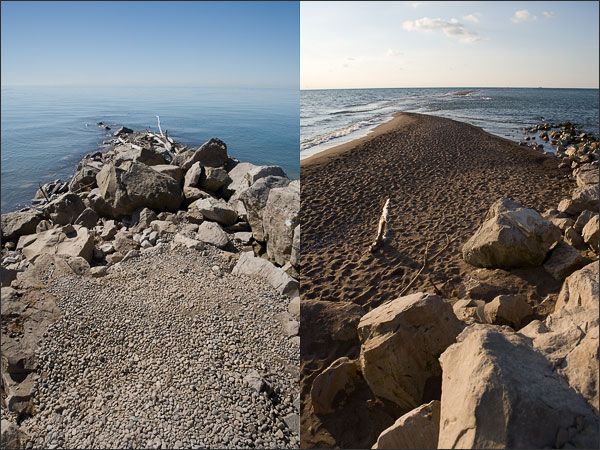
Left frame showing springtime (May), right frame showing fall (September). You can note the missing sandy beach at the left of the rocky strip. Canon 1Ds Mark II and the 24-70mm lens at 24mm. Sandy portions of the Point Pelee tip engulfed in gulls:
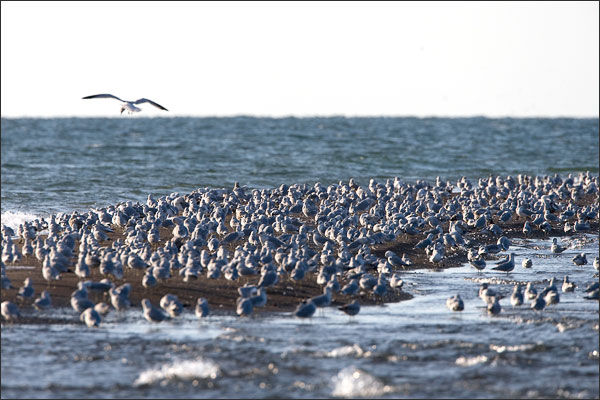
Although some portions of the Point Pelee tip were still under the water, the rest of the beach provided a welcomed retreat to the large community of gulls. Canon 1Ds Mark II and the 500mm F4 lens with 1.4X II TC. Point Pelee is offering a whole different experience in the fall for birders. As the springtime brings the competition for building the nest and finding the mate, autumn brings the quietness of the falling leaves and the hurried preparation for migration. What the 2 seasons appear to have in common is the short break before the long flight ahead, when the birds are resting and feeding in expectation of the appropriate winds. Blue Jays and their archenemy – The Sharp-Shinned Hawk On this September trip to Point Pelee, I was able to observe large and numerous flocks of blue jays, all waiting for the favorable moment to start their migration. Just as the blue jays became gently encouraged by the soft north-western winds to takeoff from the nearby trees, the sharp-shinned hawk, blue jay’s archenemy, was pushing them back into the forest’s relative protection. The hawk wasn’t the only hindrance; it seemed to me these particular flocks were a little bit confused by the winds as the blue-jays do not regularly migrate across the lake. As we’ll witness later, blue jays migrate around the Lake Erie following the shoreline.
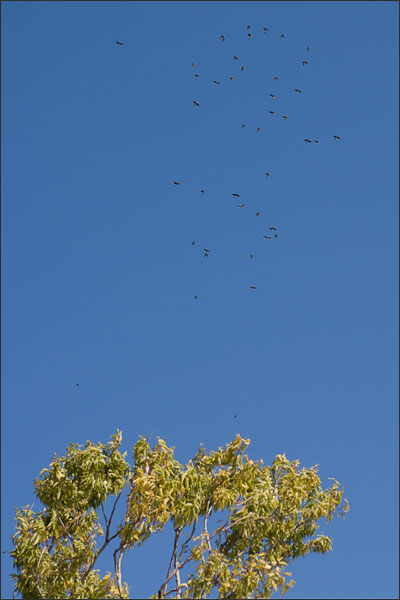
During the 5 hours I spent making photographs on the tip, this particular flock of 50+ individuals, tried to take-off 12 times, just to quickly return to the safety of the nearby tree line. A pair of sharp-shinned hawks was continually monitoring this flock’s behaviour, gliding effortlessly above the same tree line. Photograph made at Point Pelee with the Canon 1Ds Mark II and the 500mm F4 lens with the 1.4X II TC.
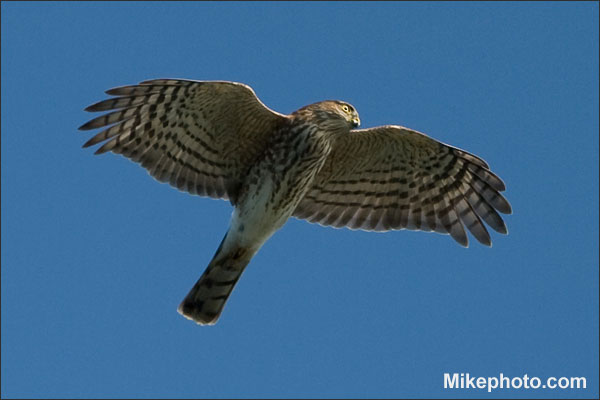
The sharp-shinned hawk watching the blue jays from a comfortable height. The hawk attacked the flock three times. At least once probably in a successful manner as neither the blue jays nor the hawk returned to the blue skies for the next half hour. Photograph made at Point Pelee with the Canon 1Ds Mark II and the 600mm F4 lens with the 2X II TC.
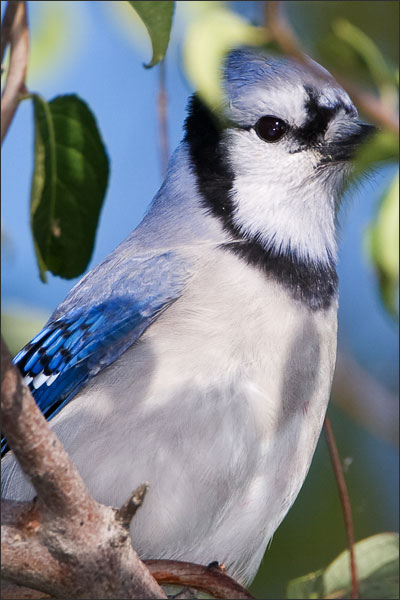
A blue jay is hiding from the sharp-shinned hawk before continuing its migration towards United States. Canon 1Ds Mark II and the 600mm F4 lens with the 2X II TC.
A Blue Sky with Blue Jays in the hundreds of thousands
On the following October trip, the blue jays were on the right migration path, along the shorelines of Lake Erie. And they were pouring in the hundreds of thousands during the first days of the month. It just happened that I have arrived at the Holiday Beach Conservation Area very early, and at the same time with Bob Pettit of the Holiday Beach Migration Observatory (HBMO). As we were setting up our gear in the Hawk Tower, the blue jays were already flying high, from east to west, in the warm light of the sunrise. When looking at the photograph below, Lake Erie’s shoreline was at my right, at approximately ½ KM distance.
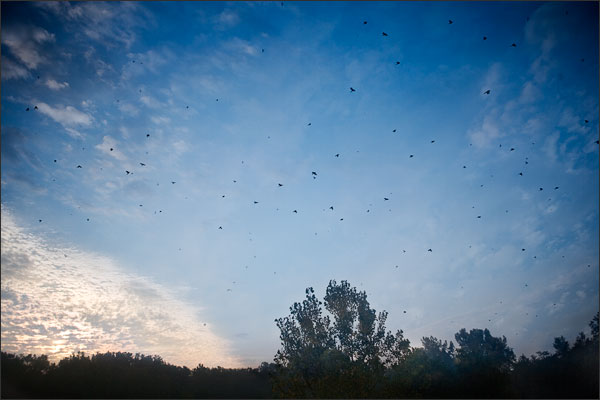
Blue Jays in fall migration. Holiday Beach Conservation Area, Canon 1Ds Mark II and the 24-70mm lens. Without containing my enthusiasm, I tried to decide the usage of either the long telephoto lens or a wider one, wondering what angle of view would best capture the quiet flow of blue jays in the blue sky. I opted for the 24-70mm and for the next half hour I shot wide open at 2.8 due to the low light levels. Little did I know that the blue jays will continue this movement, with no interruption, throughout the entire day. I’m told that each day brought an estimated count of 30,000 – 40,000 individuals, all making their way towards southern wintering locations. To my question of how many will make it to the final destination, Bob indicated that approximately 80% of them will perish in their journey.
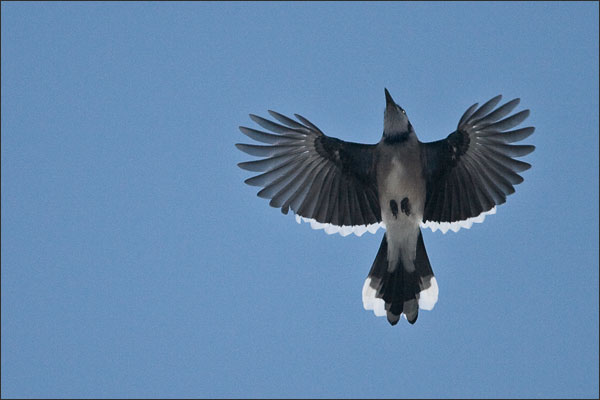
A blue jay flying above our heads; the frame captures a single individual with its white wing tips glowing in the sun rays. Canon 1Ds Mark II and the 500mm F4 lens with the 1.4X II TC.
As diurnal migrants, blue jays fly in silence. Rarely you hear them calling and those that do call are most likely stopped for a quick rest in the nearby trees. No point in drawing the most unnecessary attention of a predator when flying during the day. Along with the blue jays, numerous sharp-shinned hawks were counted, with the occasional Cooper's Hawk, Osprey and the rare golden eagle. Some of them are shown below:
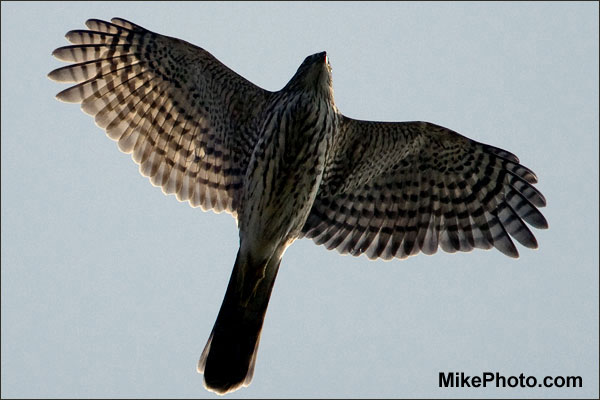
The Sharp-Shinned Hawk in fall migration, flying above the Hawk Tower. Canon 1Ds Mark II and the 500mm F4 lens with the 1.4X II TC.
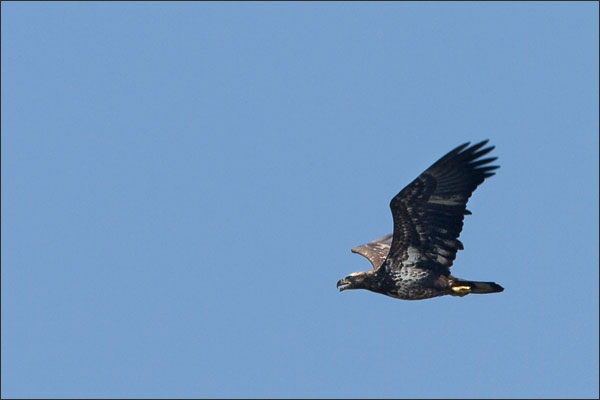
The Golden Eagle in fall migration at high altitude (see below the correct identification). Canon 1Ds Mark II and the 600mm F4 lens with the 2X II TC.
The above 'Golden Eagle' is actually an immature Bald Eagle – As pointed out by many readers by email and below in the comments section
Larry B.
"Is the "golden eagle" a baldie? What makes it Bald vs Golden? as the gentleman below wrote, the birds bill (beak) says alot. You can do some comparison of Golden Eagles both adult and juvenile compared to the juvenile Bald Eagle's bill aside from the massive structure of the bald's bill, is alot of color variation in the Balds bill on its 5 year transition to adult plumage included the cere (nose area) color. Take the adult Bald out of the comparisons as they are unmistakable. As too are the Adult golden's. Yet the juv Golden and juv Bald can be mixed up, but a few simple rules I use are 1. the bill as noted above. 2. Some feather patterns of the juv Bald has white around its axillaries, belly and leading wing edge and the juv Golden has its white feathers at the base of its primaries, some secondaries and the base of the tail (tail ending with solid black terminal band), 3. the juv Balds tailed feathers are drastically different from the juv Goldens"
Hank H.
"Mike…I was enjoying your collection of photos today. Beautiful! I particularly like the perched Blue Jay, very nice composition and coloring. Your other flight pictures are amazing, too. I imagine it is very difficult to capture pictures of birds zooming by, so I appreciate you posting these pictures. I am an amateur bird watcher and have access to a local bald eagle population. I believe the photo you have identified as a golden eagle is actually a bald eagle almost completing the molt of its juvenile feathers. The white belly is also another giveaway, as bald eagles age toward adulthood, they typically gain white feathers on their bellies, which they eventually molt their 4th year into brown feathers on the belly. I believe this is a third year bird, based on the white belly and the two remaining long juvenile secondary feathers. (There are other clues too, based on the beak.) The 4th to 5th year, they gain their all-white heads and tails and overall brown body feathers. Anyway, I hope you don't mind my thoughts about your eagle picture. Keep up the good work!"
Allen C.
Mike, Happy New Year! I was an official hawk counter at Holiday Beach from 1976-1997. Your photo labeled as "Golden Eagle" is actually a Bald Eagle. Golden Eagles never have white on the belly at any age, and also never have white anywhere in the underwing coverts. Your bird is an immature Bald Eagle, and based on the pattern of white, especially on the belly, it is probably about three years old.
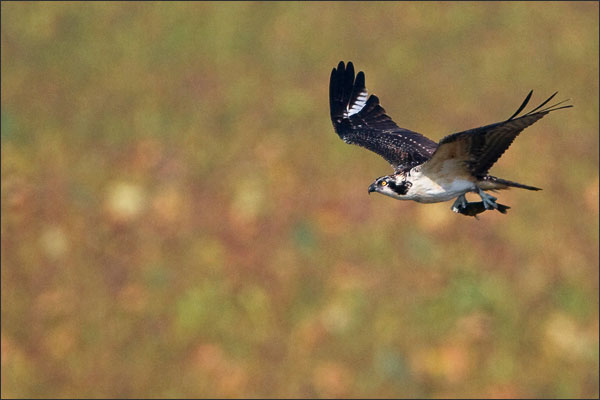
This Osprey was taking a well-deserved break from the fall migration, as it hunted three times for fish in a nearby pond, all between 7AM and 11AM. A careful investigation of the photographs at full magnification showed that each hunt was successful. The osprey carried a fish in its talons at each return to its preferred perch. The three successful hunts seemed to be enough for our osprey as the day continued with meticulous preening and attentive monitoring of the area. Canon 1Ds Mark II and the 500mm F4 lens with 1.4X II TC. I’ll leave you with one last photograph of the blue jays, as recorded at Holiday Beach Conservation Area. Bob Pettit from HBMO kept track of all the bird movement around us. As I was leaving the Hawk Tower at 1PM, Bob reported a total count of 26,700 blue jays, all recorded during a period of 6 hours. A partial day count of thousands of blue jays, flying against the blue sky, during the fall diurnal migration.
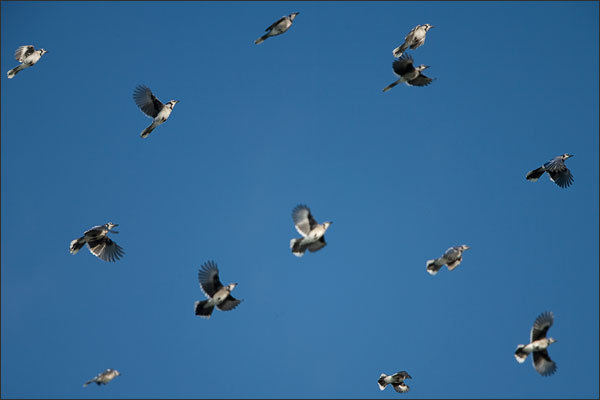
Blue Jays Flock in fall migration. Canon 1Ds Mark II and the 24-70mm lens. You can also read the part 2 of this assignment in: Fall Migration In Ontario: The Week After Update